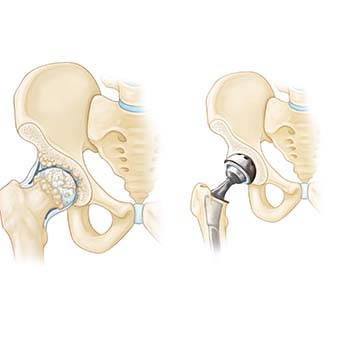Dr. Sinukumar Bhaskaran – Hip Replacement Surgeon in Pune
Total Hip Replacement (THR) procedure replaces all or part of the hip joint with an artificial device (prosthesis) to eliminate pain and restore joint movement. For this surgery, Dr. Sinukumar Bhaskaran is the best choice because he gives the best treatment at an affordable cost.
A Total Hip Replacement or Total Hip Arthroplasty consists of replacing both the acetabulum and the femoral head while hemi arthroplasty generally only replaces the femoral head.
The thigh bone (femur) and pelvis (acetabulum) joint to form the hip joint. the joint surface is covered by a smooth articular surface that allows a pain-free moment in the joint.
The cartilage cushions the joint and allows the bone to move on each other with smooth moments. this cartilage does not show up on X-ray, therefore you can see a “Joint Space” between the femoral head and acetabular socket.

Types of Hip Replacement
1. Uncemented Total Hip Replacement :
Both the socket and the stem are fixed into the bone using acrylic bone cement. This is advised for elderly patients above the age of 65 years.
2. Cemented Total Hip Replacement :
Both the socket and the stem components are fitted into the bone without using acrylic bone cement. This is a precision operation and the bone grows into the surface of the components holding them securely. This type of replacement is advised for younger patients.
3. Hip Surface Replacement :
Instead of sacrificing the worn out head of the femur (ball), only the surface is shaved off and a new surface is fitted onto the socket and the head of a femur. This is a bone preserving operation that allows patients faster recovery and patients can have a full range of movements allowing them to squat and sit cross-legged.
Surgical Procedure :
The surgery itself takes about 90 minutes. However, preparation and anesthesia before surgery and recovery after surgery will keep you in the theatre for a total of about three hours. Your orthopedic surgeon will remove the damaged cartilage and bone, then position new metal and plastic joint surfaces to restore the alignment and function of your hip.
Many different types of designs and materials are currently used in artificial hip joints. All of them consist of two basic components: the ball component (made of a highly polished strong metal) and the socket component (a durable plastic cup which may have an outer metal shell).
Acrylic surgical bone cement may be used to fill the gap between the prosthesis and remaining natural bone to secure the artificial joint.
An uncemented prosthesis has also been developed which is used most often in younger, more active patients. The prosthesis may be coated with textured metal or a special bone-like substance which allows the bone to grow into the prosthesis.
A combination of a cemented ball and a noncemented socket may be used.
